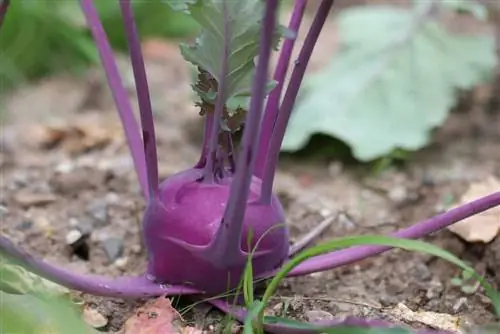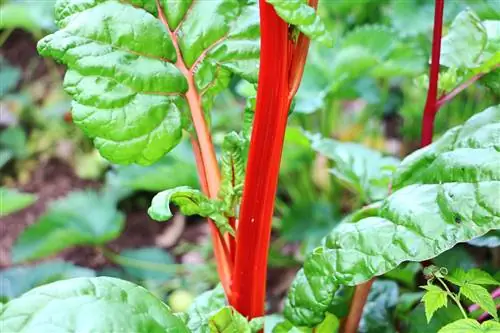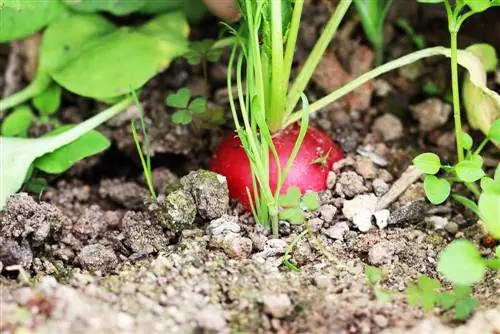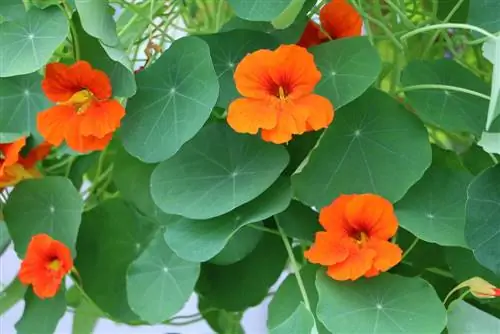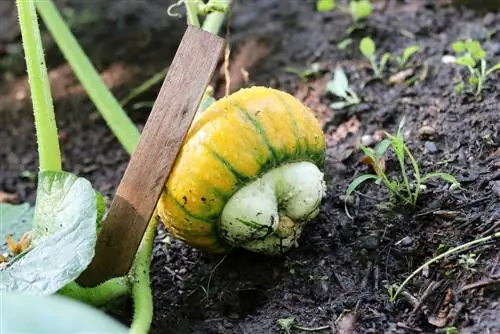- Author admin [email protected].
- Public 2023-12-17 03:39.
- Last modified 2025-01-24 12:45.
The kohlrabi belongs to the cruciferous family (Brassicaceae) and is basically a biennial plant. In local regions, however, the beetroot is usually cultivated as an annual because it forms a tasty tuber in the first year, which is usually harvested. However, if you cultivate the plant as a biennial, you can enjoy its beautiful inflorescences in the second year. The vegetable plant is mainly grown outdoors and is considered particularly beginner-friendly.
The cultivation
The kohlrabi can be harvested from the end of February orGrow on the windowsill at the beginning of March or in the greenhouse from mid / end of March. What is essential here is the optimal temperature, which should be between 12 and 16 degrees. The kohlrabi can easily tolerate slight temperature fluctuations as long as it is not colder than 10 degrees. Because then there is a risk that it will not form a tuber later. In addition, the warmer it is, the more light the kohlrabi needs. Because too little light at temperatures that are too high can lead to horny growth. The swede forms thin shoots and only rarely a tuber.
But not only the optimal location is essential for successful cultivation, but also the ideal equipment. In addition to the potting soil, the containers in particular play an important role. Individual pots with a diameter of around 4 to 5 centimeters are best. Alternatively, conventional bowls or yogurt cups can be used. For larger quantities, the use of pot plates or peat soaking pots has proven useful. Once the optimal conditions have been created and the necessary equipment is available, you can start growing the kohlrabi:
- Fill the growing soil into the containers
- Sow seeds thinly into the containers
- then cover lightly with soil
- and keep evenly moist
- after a few days the seeds will start to germinate
- then the first tips appear
- As soon as the first leaves have formed, the seedlings can be kept cooler
- However, the temperature must not fall below 10 degrees
- from April the seedlings can be planted in the vegetable patch
Tip:
Alternatively, seedlings can be purchased in garden centers and then planted in the bed from April. When purchasing seedlings, it is important to ensure that they have a firm root ball with many fine white roots.
Sowing in the vegetable patch
Kohlrabi are medium-feeders, which is why an adequate supply of nutrients is essential for their growth. Direct sowing should only be carried out if the soil has been prepared for it in late autumn. Here the soil is freed from coarse soil obstacles and richly enriched with compost. It is particularly advantageous if the compost is mixed with cow manure before it is incorporated. Once the soil is prepared, it must rest over the winter. Sowing can generally take place the following year from mid-April as soon as the ice saints are over. If there is a risk that the temperatures will fall below 10 degrees, the vegetable plants should also be covered with a fleece. The latest time for sowing outdoors, however, is the end of June. When direct sowing, it is best to proceed as follows:
- draw a small groove with a rake
- this should be about 1 cm deep
- Sow seeds evenly in the groove
- 3 seeds can easily be sown per plant spot
- Planting distance should be around 30 x 30 cm
- thicker varieties require more space, namely around 40 to 50 cm
- If the plants don't have enough space, cylindrical tubers could form
Tip:
If you want to harvest regularly, you should plant kohlrabi at a different time. An interval of around two weeks has proven to be effective for this.
Pricking
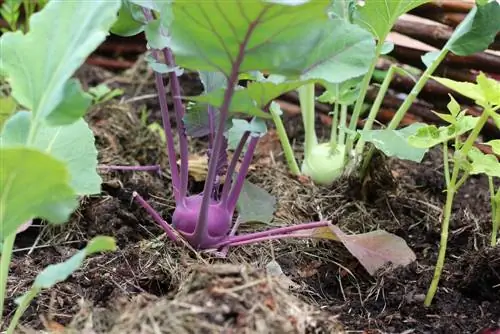
If all the seeds develop after sowing, it is necessary to prick out the plants. When thinning, the strongest plants are left standing and the others are carefully removed from the soil and moved about 10 to 15 centimeters. It is important to ensure that the plants are neither planted too deep nor too shallow. If they are planted too flat, they do not have enough support and can tip over. However, if the plants are planted too deep in the soil, the tuber has contact with the ground and therefore comes into contact with various soil organisms. This in turn means that the tuber can be damaged by the organisms. Proper pricking is therefore essential to ensure he althy growth.
- choose a new plant location
- Drill a hole in the ground
- either with your finger or with a pricking stick
- Touch the plant between your thumb and forefinger
- or use the pricking stick
- Carefully remove the plant from the soil
- shorten the roots slightly
- insert into the new plant location with the roots facing down
- Leaves should not be in contact with the ground
- then press and moisten the soil
The Cultivation
Kohlrabis thrive best in freshly moist, humus-rich soil. This should be slightly acidic to neutral, with a pH value between 6.0 and 7.0 being considered optimal. The vegetable plants prefer a sunny, warm location, which should also be protected. Although the beet has relatively low demands on the soil and nutrient supply, it is even more demanding when it comes to its neighbors. Growing them alongside other cruciferous vegetables is definitely not recommended and replanting brassicas in the same place should be done with an interval of around 3 to 4 years. But kohlrabi can easily be grown alongside numerous other plants. His good neighbors include:
- Beans
- Dill
- Peas
- Strawberries
- Cucumbers
- Salad
- Spinach
- Radish
Tip:
Growing kohlrabi next to tomatoes can prevent cabbage white butterfly infestation. Tagetes protect kohlrabi from nematodes and cut celery reduces the risk of infestation by flea beetles and caterpillars.
Care
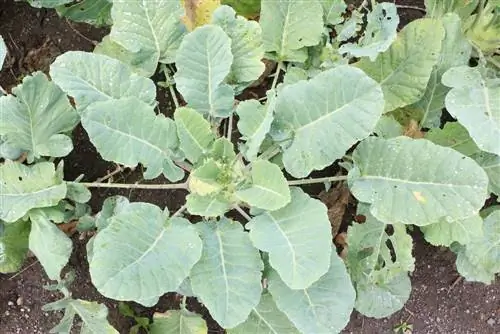
Proper care of kohlrabi is essential for he althy growth and a rich harvest. Because planting and care errors can cause the kohlrabi to start sprouting. The stem beet “shoots up” and forms long, soft and thin shoots. These hardly develop any tubers, but instead form flowers. However, this can be avoided if the plant is cared for properly. The maintenance effort is relatively low and is as follows:
Fertilize
- Soil preparation in late autumn is essential
- All organic fertilizers are suitable for fertilizing
- such as horn meal or nettle manure
- fertilization is carried out continuously with small amounts
Pouring
- regular watering is one of the most important care measures
- If you water too little, the tubers can burst
- water well, especially on dry days,
- that's why water daily in summer
- keep the soil constantly and evenly moist
- but definitely avoid waterlogging
- only water from below
- This prevents water residue from settling on the leaves
Tip:
Regular watering can also prevent the fruit from becoming woody!
Diseases and harmful images
In addition to the plant becoming rotten and the tubers bursting, a wide variety of diseases and pests also pose a danger to the kohlrabi. A common damage pattern is so-called heartlessness. This can be caused by pests as well as genetic defects. After the kohlrabi have created a few leaves, they do not form any additional leaves at their growing points. A clear sign of a genetic defect are the terminal leaves that appear sporadically in the crop and are funnel-shaped or needle-shaped. The kohlrabi also often suffers from the following diseases:
Bottle formation
- usually occurs in early spring
- Temperatures of 5 to 12 degrees promote deformation
- Symptoms: the spherical tuber shape changes to a “bottle shape”
- Cause: temperatures too low
Downy mildew
- commonly occurs in spring and occurs in autumn
- Symptoms: light fungal growth on the underside of the leaves
- and yellowish spots on the leaf surface
- Measure: remove infected parts of the plant, dispose of the plant if the infestation is severe
- prevention: uniform water supply, sufficient planting distance, nettle manure
Clubroot hernia
- Fungal infestation that penetrates the roots through the soil
- tumors form on the roots, leaves are not supplied with enough water
- commonly occurs in the summer months
- Symptoms: leaf yellowing, root thickening, plant death
- Measure: Dispose of the plant, but not in the compost
- prevention: regular crop rotation, loosening impermeable soils, adding lime
vein blackness
- Bacterial disease that occurs mainly in summer and autumn
- warm, humid weather favors the occurrence
- largely older leaves are damaged
- Symptoms: v-shaped, yellow-brown spots, black leaf edges and veins, stunted growth
- Measure: remove diseased plants immediately
- prevent: consistent crop rotation, avoid wet soils
Pests
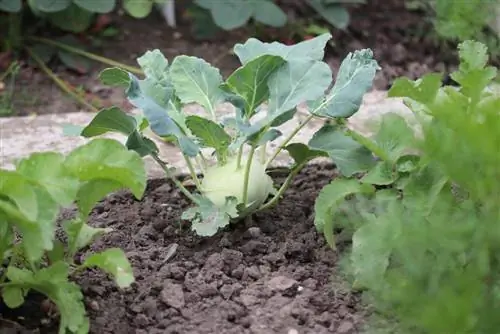
The kohlrabi are often plagued by pests and other animals. Birds such as pigeons in particular like to snack on the vegetable plant. But rabbits and hares also appreciate the tasty kohlrabi. It is not uncommon for the animals to nibble on the vegetables throughout the season, with rabbits particularly nibbling on the young plants in spring. The feeding damage can be seen in eaten leaf parts and hearts as well as in pieces of leaves on the ground. Although the plants can survive this damage without any problems, it is still usually undesirable. A protective net makes it more difficult for animals to access the vegetable plants and thus offers protection from damage caused by feeding. However, if the kohlrabi are attacked by pests, caution is advised, as in the worst case this can lead to the death of the plant.
Flea beetles
- tiny black or yellow striped beetles
- mainly damage young plants
- Infestation is favored by warm, dry weather
- Symptoms: Leaves have sieve-like holes
- Measure: manure made from wormwood or tansy, hedgehogs, shrews, pesticides
- prevention: always keep the soil moist and mulch, hoe regularly
Cabbage gall weevil
- small, gray weevils lay eggs on plant stems
- the larvae feed on the plant tissue
- Symptoms: spherical growths on the main root or root neck
- Measure: dispose of infected plants, parasitic wasps, shrews
- prevent: destroy young plants with infestation
Whitefly
- About 2 mm small flies damage the plants by sucking
- and lay their eggs in the leaves
- can cause the plant to wilt and die
- Symptoms: Leaf surface is covered with a sticky honeydew
- Measure: Plant protection products, parasitic wasps, yellow tablets, tobacco decoction
- prevention: spread vegetable protection nets, pull weeds regularly
Harvesting and storage
As a rule, kohlrabi is harvested before it has reached its final size. At the end of the growth period, many varieties develop woody cells at the base of the roots, causing the fruits to lose their often fine, nutty taste. That's why the beetroot is harvested while it is still a little smaller. Depending on the variety, the diameter of the tubers is between 5 and 20 centimeters and the weight varies from 100 grams to eight kilograms. Basically, the vegetable plant is ready to harvest around six to eight weeks after sowing, with the optimal time usually being noted on the seed bag. The rule of thumb also applies: When the tuber has reached the size of a tennis ball, it can be harvested. The best way to harvest is as follows:
- take a sharp knife
- First sterilize this with alcohol
- cut the plant below the tuber
- and remove the larger leaves
Tip:
The kohlrabi lasts about 2 to 6 days if stored in the cellar or refrigerator. To extend the shelf life to around 2 weeks, the tuber is wrapped in a damp cloth and placed in the vegetable compartment of the refrigerator.
Conclusion
Growing kohlrabi does not require much care as the plants are comparatively undemanding. When caring for them, however, it is important to ensure that the plants are always provided with enough water and checked for possible pests. Thanks to the low work effort, the vegetable is ideal for beginners!

